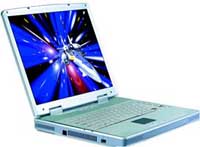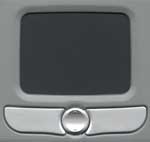Construction - Build, Appearance, Size
What exactly is the i-Buddie 4? Well, according to ECS, the i-Buddie 4 is a "desknote", suggesting that the i-Buddie 4 is a cross between a desktop machine and a notebook one. That is exactly what the i-Buddie 4 is and all the other ECS desknote computers are. Many of you may be familiar with ECS as a motherboard producer, but why did they decide to enter the cutthroat world of mobile computing? It seems that the company just had an innovative idea and decided to run with it.
The outside appearance of the i-Buddie 4 closely resembles many other notebooks we have seen. The system's dimensions place it in the desktop replacement class notebooks and is colored in a fairly conventional silver and light purple color scheme. The system casing is plastic, reinforced with a metal chassis.

The system is opened by sliding a small lever located on the front side of the system's screen. The locking mechanism on the i-Buddie 4 is one of the more unique ones we have seen. The system's screen is held in place by two magnetic hooks that come up to attach to the screen only when the screen is closed. Since the hooks are on springs, when not in use they hide inside the bottom half of the system.
Lifting up the screen reveals the i-Buddie 4's 15" XGA or SXGA+ LCD panel. As one would expect in a system of this size, the keyboard on the i-Buddie 4 is a full sized 85-key keyboard. The keyboard's home, page up, page down, and end keys are located on the right side with the dedicated arrow keys on the lower right side. The keyboard was generous, with a 19mm key pitch. The keyboard was easy to type on but the keys felt somewhat loose. As a result of the loose keys, the i-Buddie 4's keyboard was fairly noisy, as the keyboard rattled when in use. Another small complaint is the fact that, like many notebook keyboards we have seen, the i-Buddie 4's keyboard includes a function key that is placed in the location where the control key is typically found. This pushes the control key over one spot and introduces a learning curve into the system.
The i-Buddie 4's touchpad is located slightly to the left of the system's center to place it in the middle of the hands when typing on the keyboard (remember, the right side of the keyboard is home to some function keys). The touchpad on the system was fairly small when compared to others we have used but seemed to get the job done. The left and right buttons fall below the touchpad are are centered around a small circular button that serves as the scroll up and scroll down buttons.
The system is large and, as a result, has a quite generous wrist rest area. Also found in this region are the system's internal microphone (located to the upper left of the touch pad) and two speaker ports (on the extreme left and right sides of the system). As we soon learned by taking the system apart, the speaker ports on the wrist rest area are simply for looks, as the speakers point out towards the front of the system. Because of this, it was not a big deal that our hands often covered these ports when typing. The same cannot be said about the location of the internal microphone. The small hole was easily covered during any normal computer use with hands on the keyboard and since the microphone is really located here, audio-input was not very effective.
Above the keyboard is a large grilled area which we assumed was used for ventilation as well as looks. Powering the system on reveals that the only part of the area that is used for ventilation is the left side, where a fan mounted under the grill sucks air from outside to cool the CPU. Above the grill area are a set of three silver buttons. The middle button serves as a power button for the system, while the button to the left comes set to launch the default browser and the one on the right launches the default mail application. Above the buttons are four status LEDs, one for hard drive activity, one for number lock status, one for caps lock status, and one for scroll lock status.
Also visible on the keyboard surface of the i-Buddie 4 are two additional status LEDs: one for power state (on or off) and one indicating standby mode.












0 Comments
View All Comments